
Approveit vs ApprovalMax: which one is best for your business?
- Compare
- 13 min read
ApproveIt vs ApprovalMax: Which Approval Automation Software is Best for Your Business?
Business is all about making decisions. What supplier to choose for your goods? What contract terms would be most beneficial? To pay or not to pay a certain invoice?
To make sure your team makes the best decisions that lead to maximising revenue, the process of making those decisions has to be formalised and transparent.
Thanks to the vision of business process owners who have discovered the importance of bringing transparency to decision-making, approval automation software is being promoted more and more actively.
Automation software helps avoid mistakes and encourages accountability and compliance with internal processes among employees.
Choosing the right approval automation platform for your business will determine whether you improve your internal communication and generate more revenue with its help, or you’ll simply have one more bill to pay with no ROI in sight.
In this article, we’ll compare two competing approval automation platforms: Approveit and Approvalmax.
The former is a promising startup, the latter has been in the market for over a decade. Both have a lot to offer, so we hope this particular article will help you make the right decision for your business.
Grounds for Comparison
We created a demo organization to compare Approveit and ApprovalMax and compared two approval automation apps in the following categories
- Usability
- Integrations
- Scalability
- Customization capabilities
- Price
Let’s go point by point.
Usability
Both Approvalmax and Approveit are workflow-based.
That means that to start an automated approval process, you have to set up the rules:
- What data needs to be submitted for approval
- How many approval steps are required
- How many approvers are required for each step
- What are the conditions for each step to trigger
First thing that jumps out is that in Approveit the UI is in line with the latest tendencies and feels more lightweight. The Approvalmax interface looks more traditional but is a bit harder to navigate.
Once you’re logged in to Approveit, you see the Dashboard with top requests awaiting your action, total pending received and sent requests, and general team statistics.

Approvalmax does not have a dashboard, and once you’re logged in and you have nothing to approve, it looks like this:
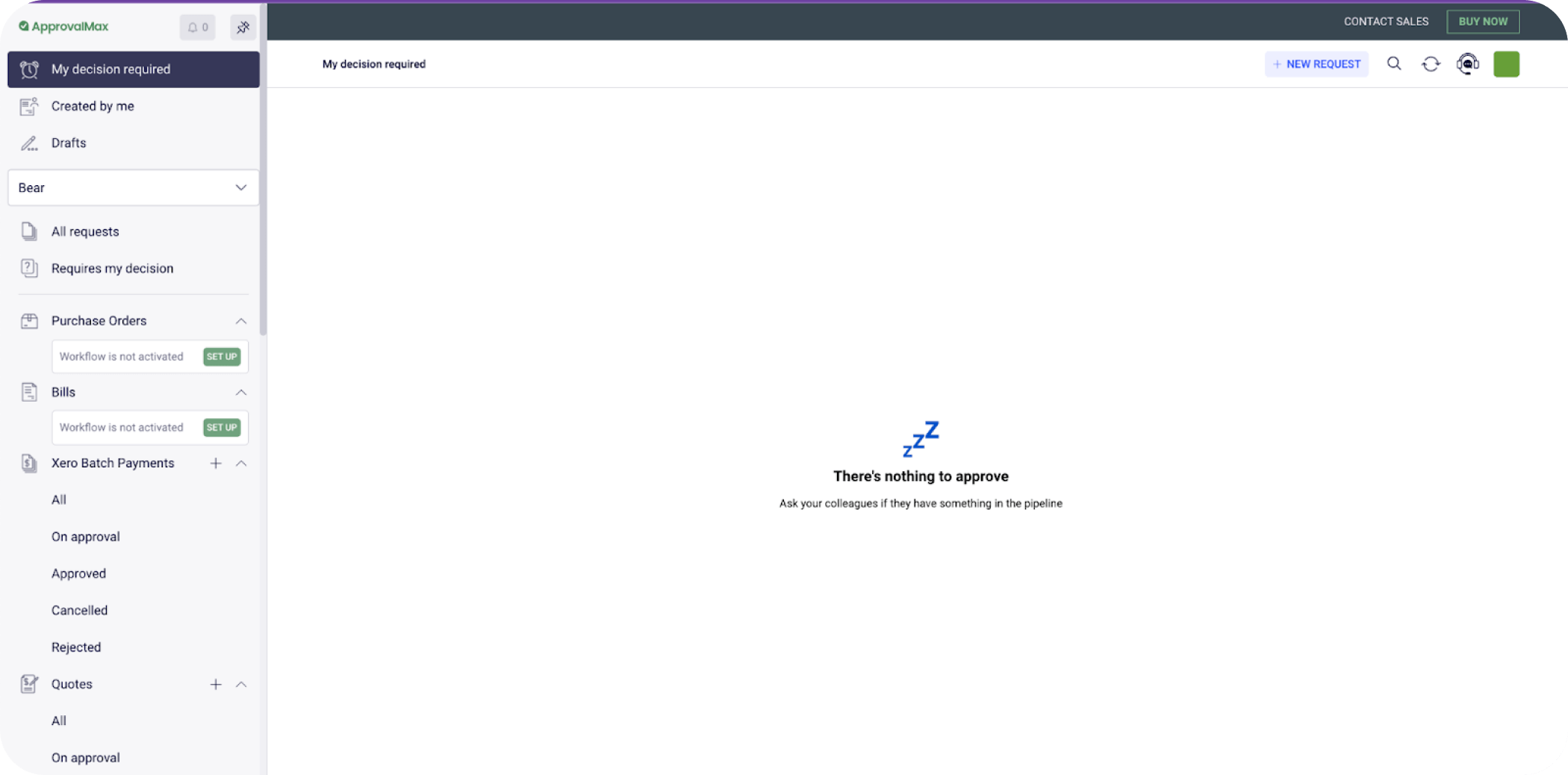
It might be confusing for new users since all they see upon signing up is an empty screen, but it’s the type of confusion that is easy to overcome.
The first thing you need to do to kick off the automation process is choose a workflow template; that’s how it looks in both apps:
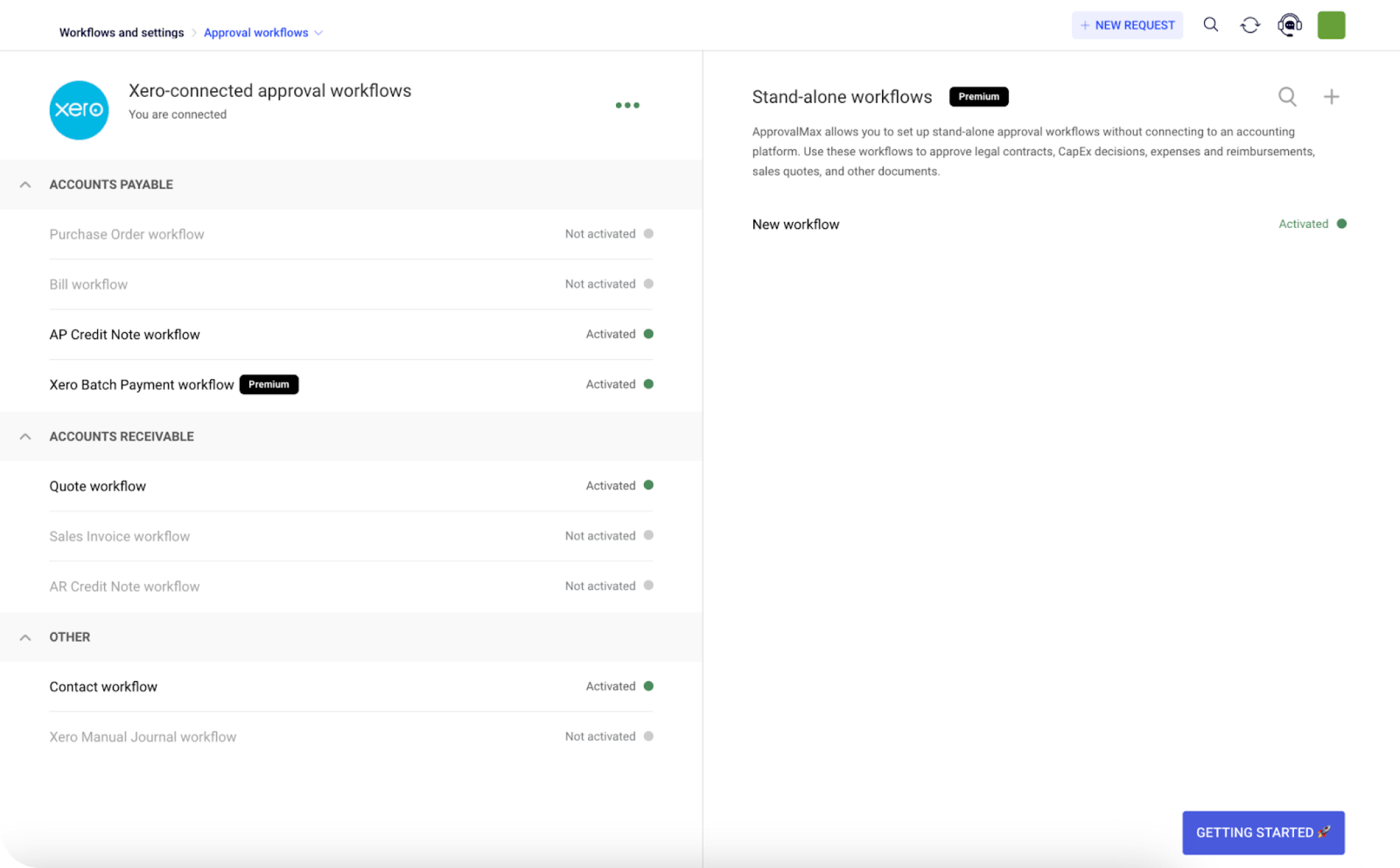
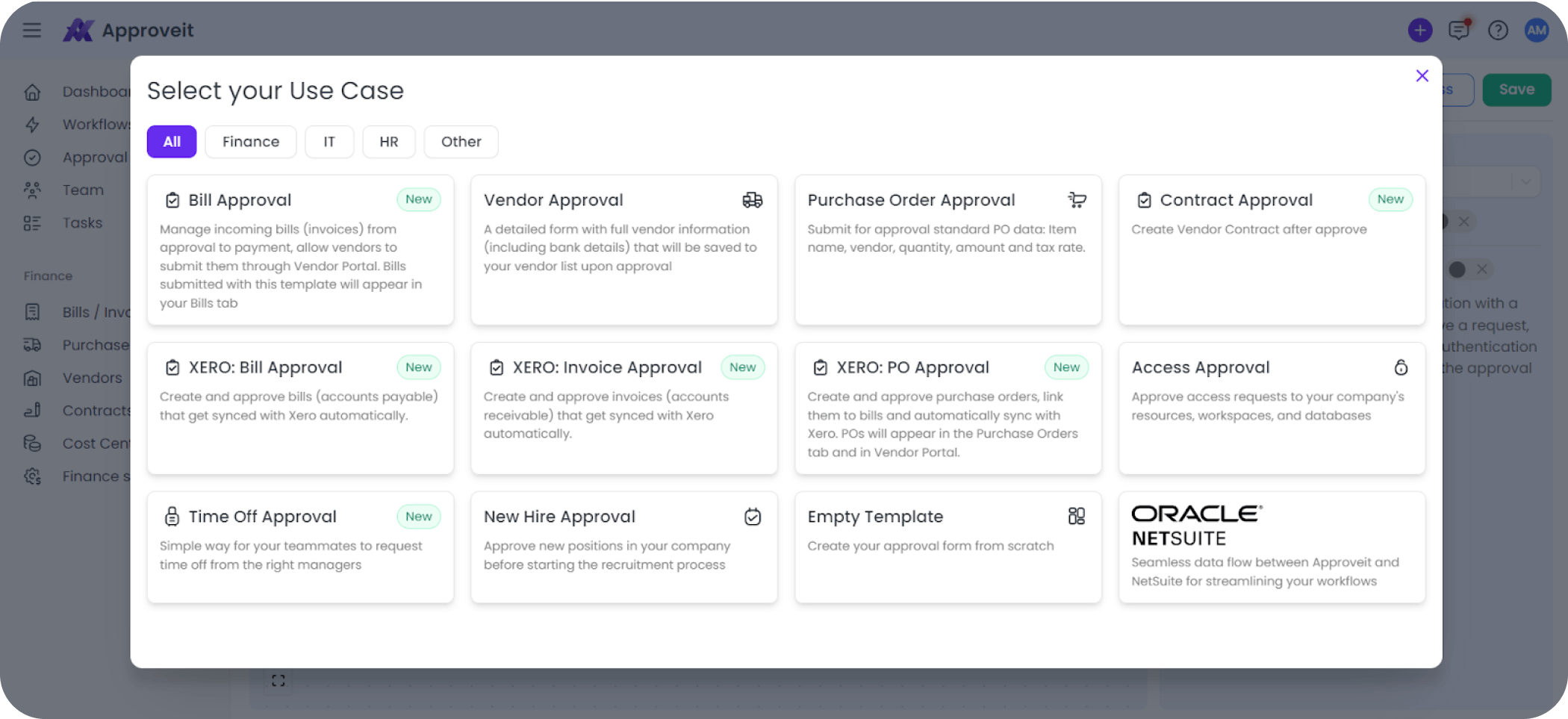
You may notice that Approveit’s choice of templates is not limited to finance and accounting: time off approval, contract approval, new hire approval, access approval.
Empty template allows you to configure any sort of workflow by creating your own intake form and the steps that follow approval.
Approvalmax is mainly focused on finance & accounting and specifically in association with Xero, QuickBooks, or NetSuite* (*custom integration not available for exploring during trial). It offers credit notes and batch payments approval flows that Approveit does not yet support.
Stand-alone workflows are a relatively new feature in ApprovalMax that is only available with Premium subscription whereas Approveit started building its functionality on the foundation of stand-alone workflows and they are included in all subscription plans.
But once we’re in the workflow builder, Approvalmax gains an edge in showing the approval flow in more detail.
That has to do with differences in functionality – Approveit allows more than one intake form to be filled within one workflow, inbound and outbound integrations, tasks, and post-approval automated actions. That’s why the approval flow and workflow stages are separated.
Approvalmax allows to add only approval and auto-approval steps. Approveit on top of that brings in tasks and automated actions.
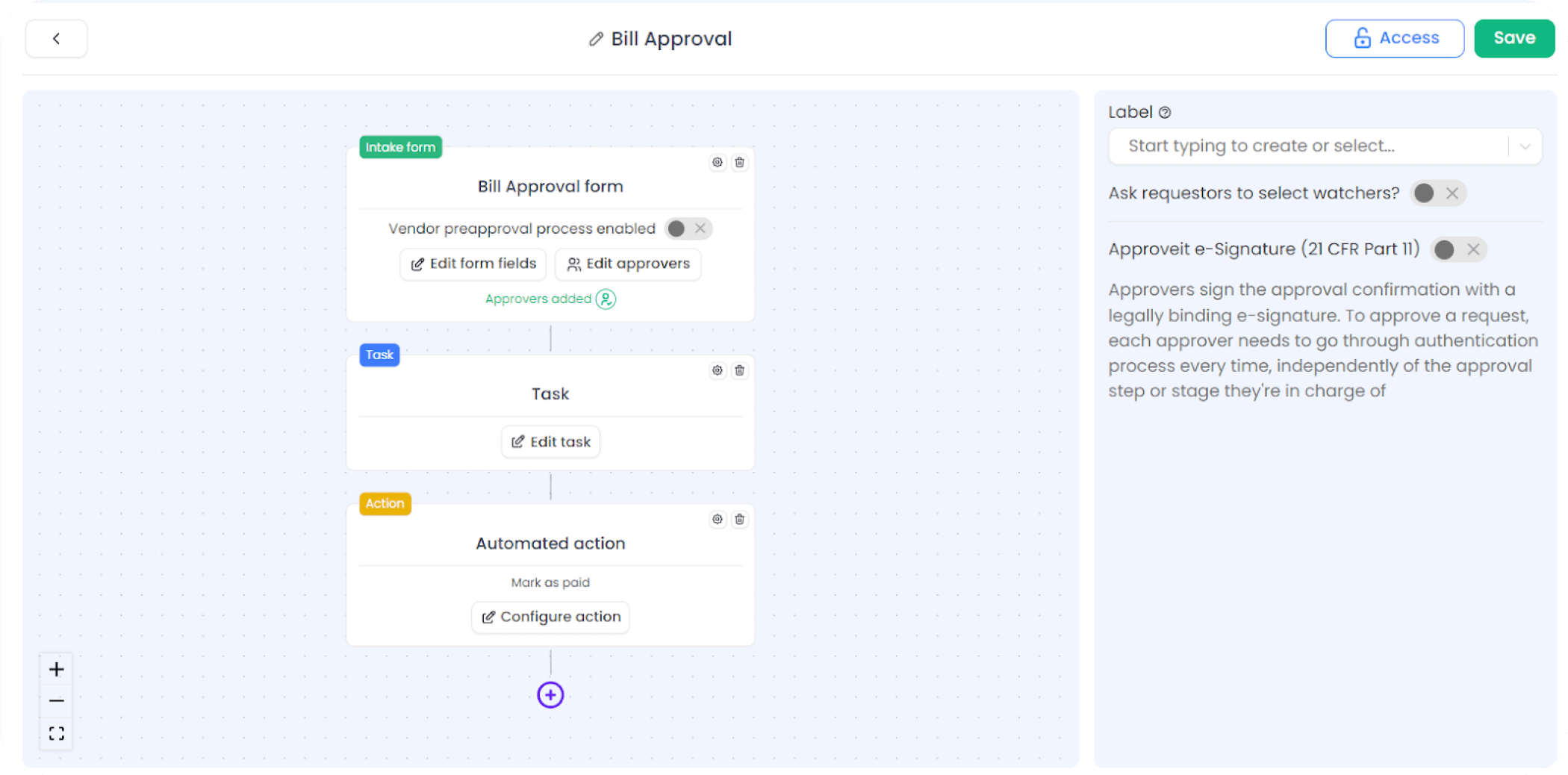
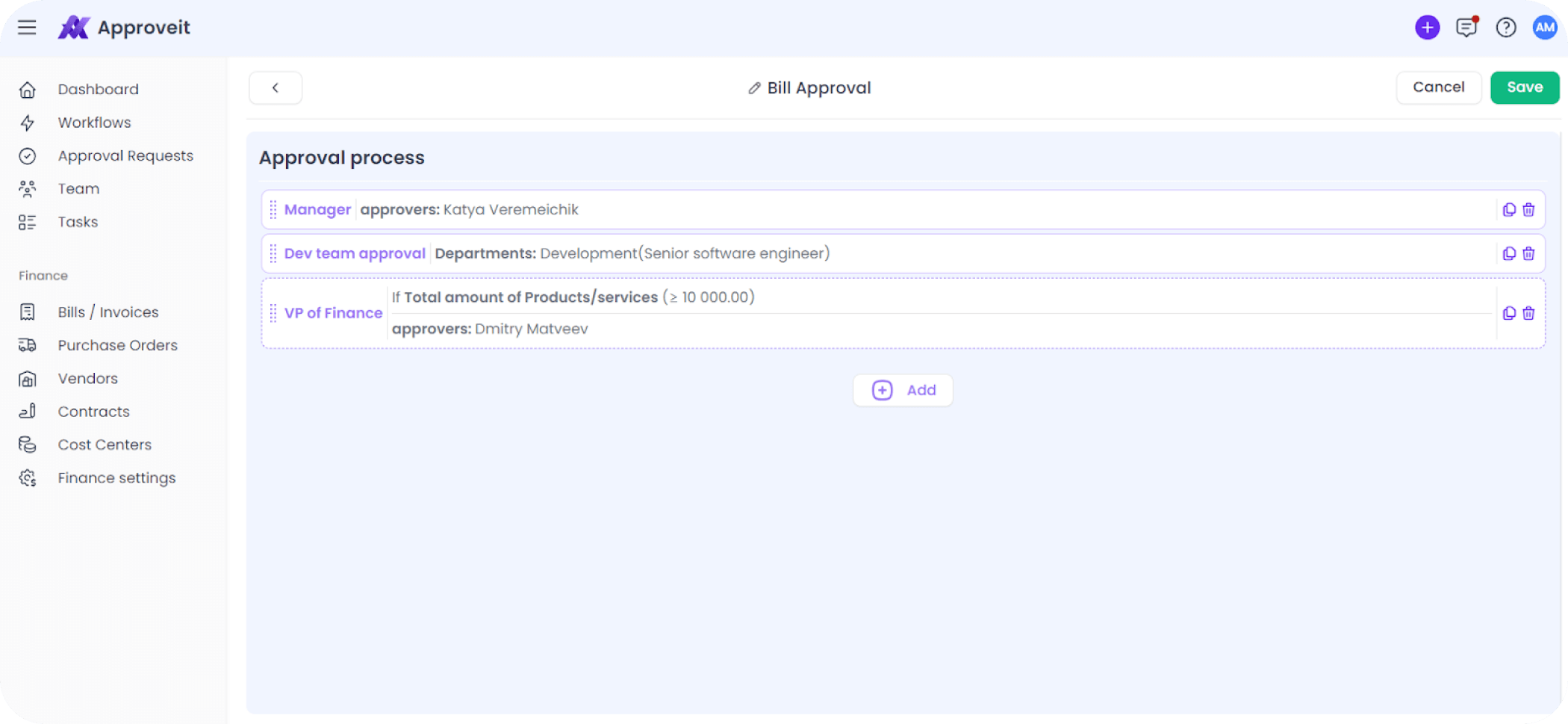
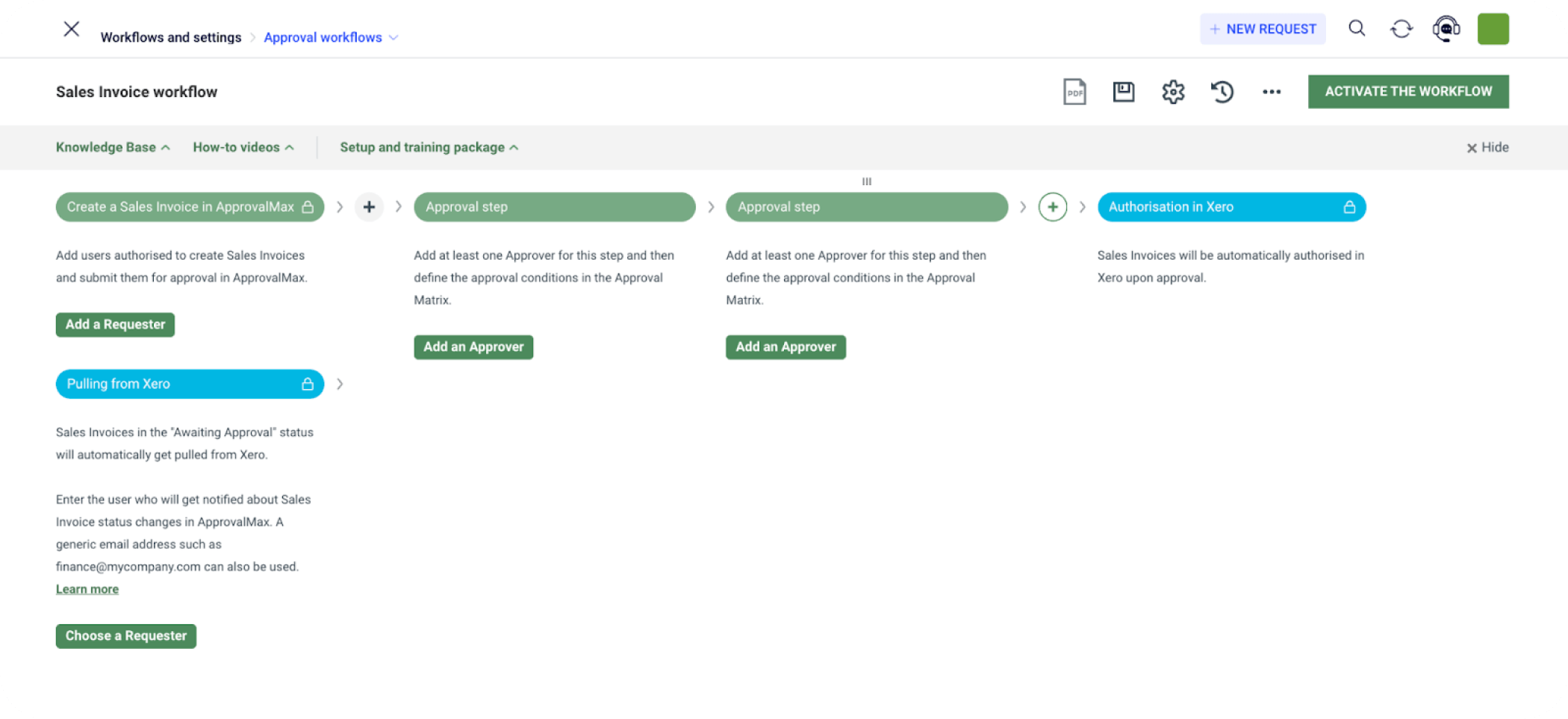
You’ll notice way more additional tweaks to the workflows in Approveit than in Approvalmax. That’s great in terms of flexibility and customization but may increase the time you’d have to spend on the setup.
The approval requests section exists in both apps.
Approveit offers a detailed view of each request and allows filtering the data to compile detailed reports on each workflow from this tab. It also allows a board view of all requests to give you an overview of current statuses.
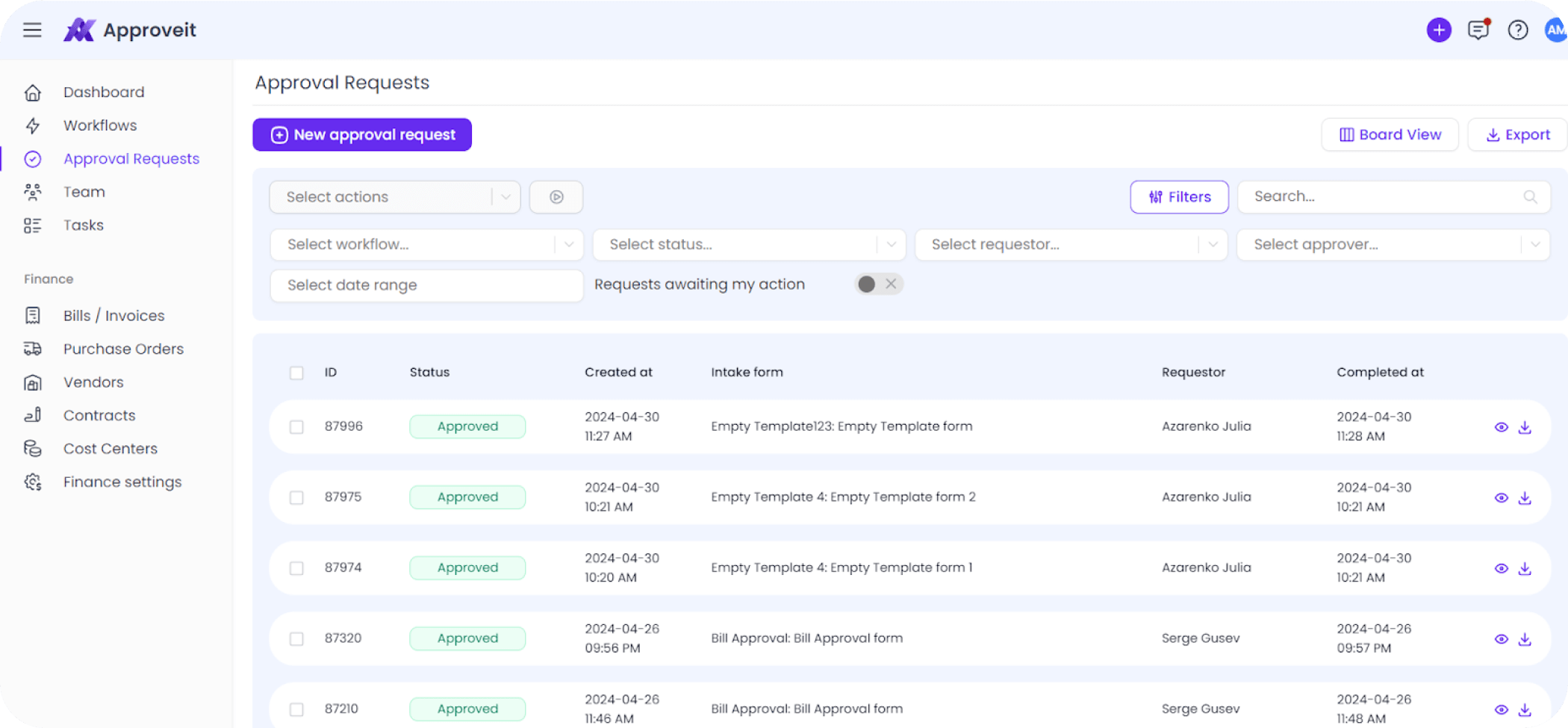

Approvalmax keeps it simple and only displays the request and its active status.

However, detailed reporting is available in Approvalmax, just in a different section called “Reports”. It allows you to configure and save reports you use frequently. The UI of this section is pretty intuitive and leaves little space for misunderstanding.


Now to the request itself. In Approvalmax the detailed view of the request looks like this


It contains all the necessary information about a given request. Including a so called Audit Trail – a log of all happenings to this request.
Approveit is very similar, the audit trail here is called “journal”.
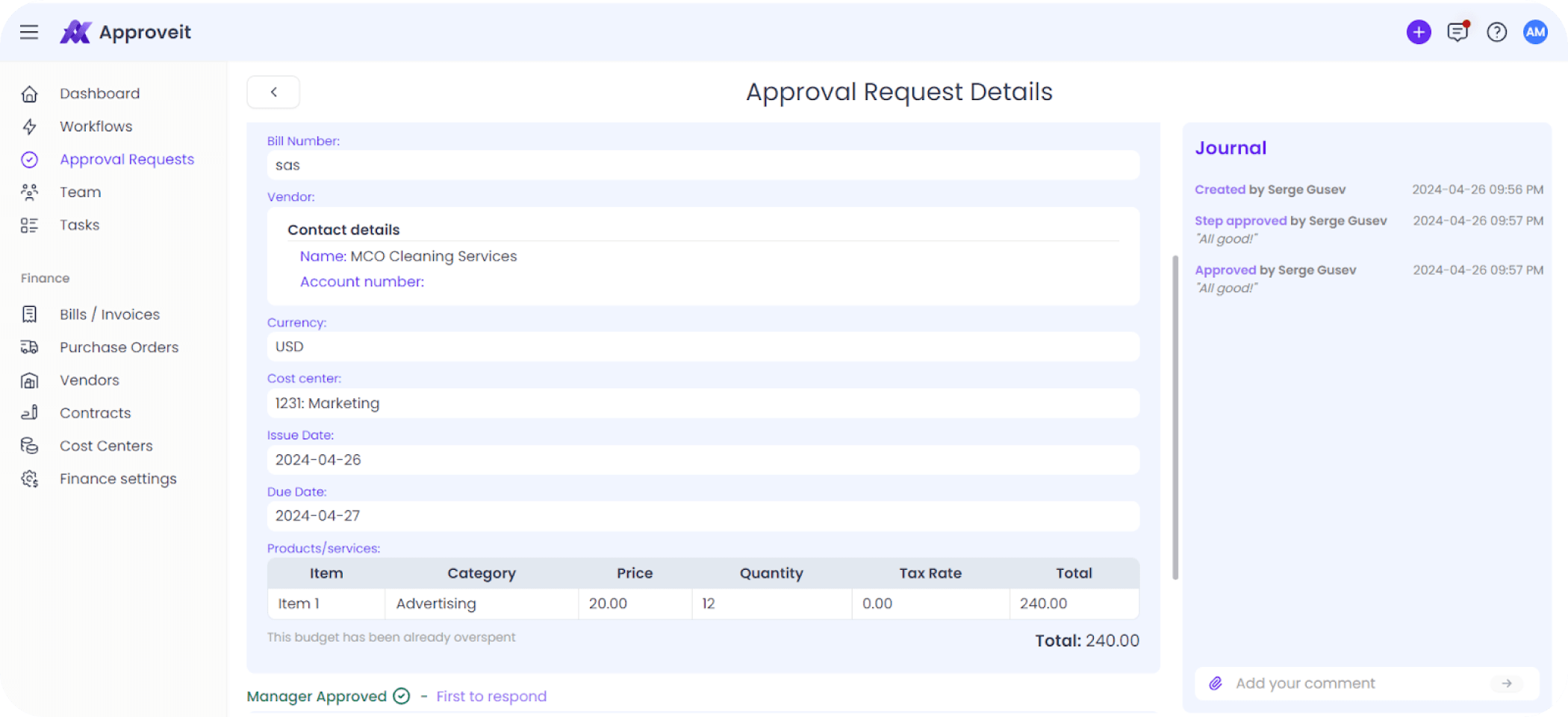
Managing users is similar in Approveit and Approvalmax.
Approvalmax currently offers more access levels (roles), but does not allow time off tracking and organizational structure setup. Substitute approvers (in case someone’s on leave) are added in the team tab in Approvalmax, in Approveit substitute approvers can be chosen in the personal settings of each user.
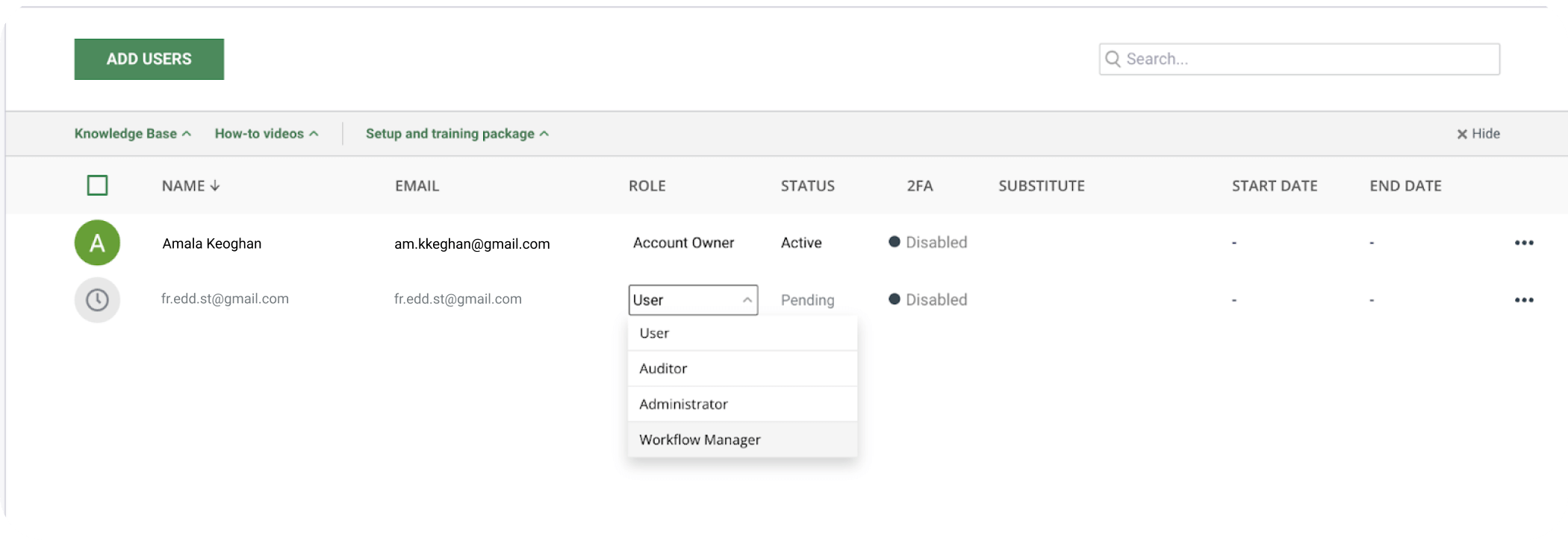
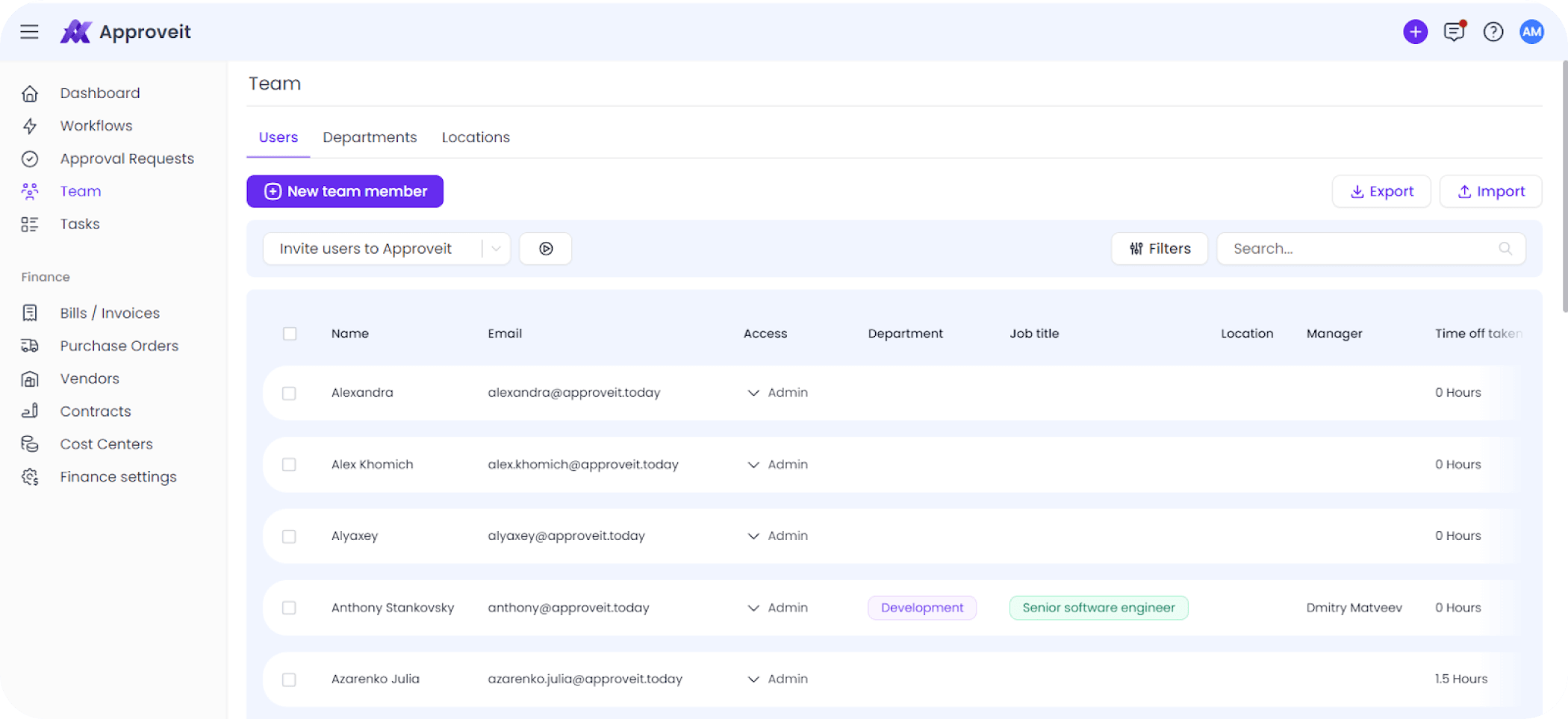
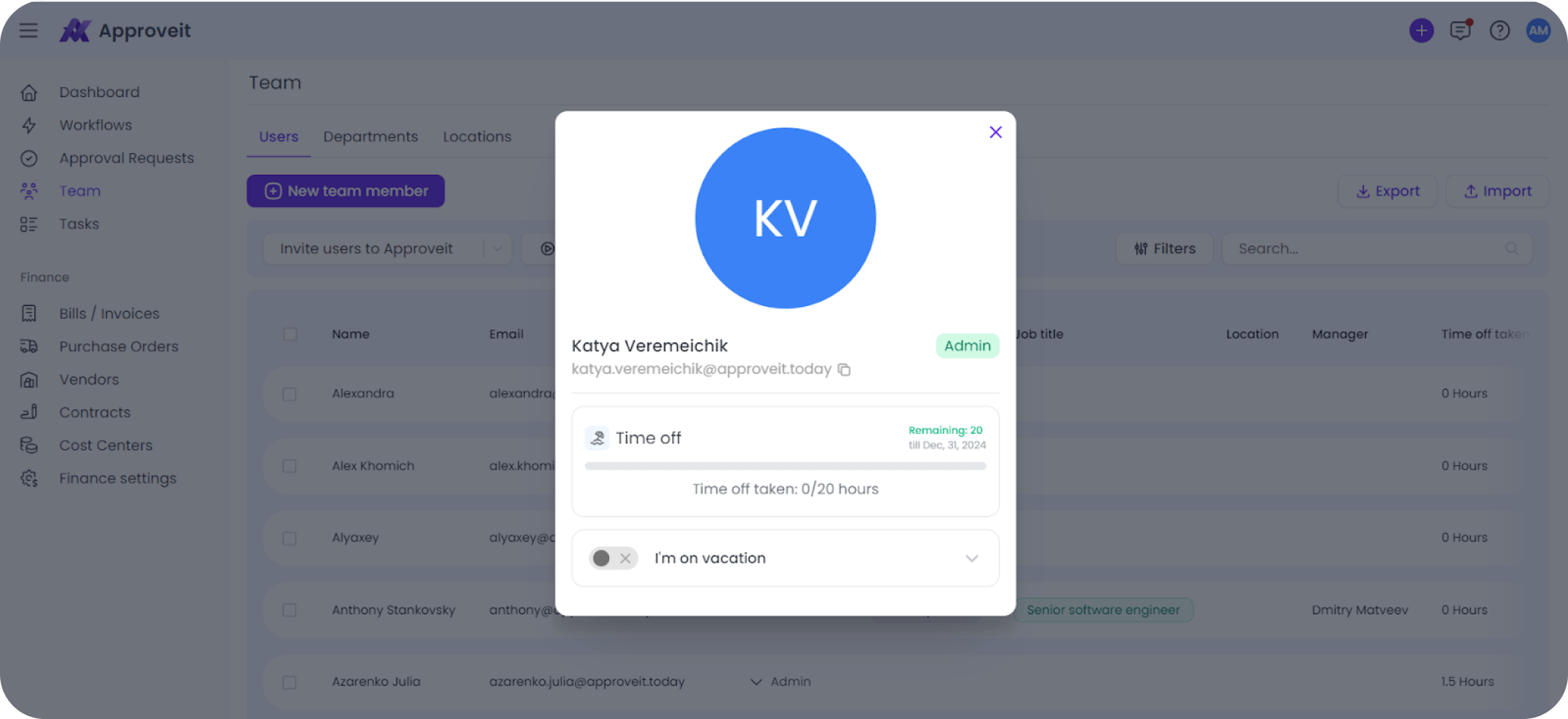
It seems that in Approveit the user flow is more straightforward and intuitive. The usability of the platform as a stand-alone solution by far exceeds Approvalmax’s, offering more use cases and more independence, however, Approvalmax gains the upper hand when it comes to report configuration and integrations with Xero and QuickBooks. But we’ll get to that later.
Summary table
| Feature | Approveit | Approvalmax |
| Interface | Light-weight and intuitive | Traditional, but a little harder to navigate |
| Dashboard | ||
| Approval flow display | ||
| Auto-approvals | ||
| Workflow templates | ||
| Reports | ||
| Saving reports | ||
| Team management | Extensive, includes time offs and org structure | Limited to Approvalmax roles |
| Access levels | Two | Four |
| Requests sorting | ||
| Requests status board view | ||
| Comments to requests | ||
| Request log | ||
| Stand-alone usability | High | Limited |
| Workflow components | Intake form, approval flow, tasks, automated actions, inbound and outbound integrations, vendor pre-approval stage. | Intake form, approval flow, outbound integrations |
Integrations
Before we get to discussing customisation and scalability of both products, we need to understand how they work a bit more.
Particularly, in the realm of integrations, since a huge share of the functionality of both apps hinges on them.
Table will be the best way to explore integrations
| Integration | Approveit | Approvalmax |
| Slack | ||
| Microsoft Teams | ||
| Xero | ||
| QuickBooks Online | ||
| Jira | ||
| Cin7 Core | ||
| SoftLedger | ||
| NetSuite | ||
| BambooHR | ||
| Google Calendar | ||
| Zapier | ||
| API |
Now that we see the overall picture, let’s get into details. Each integration will make more sense as we go.
Slack
Approveit was initially based on the integration with Slack.
Right from Slack, you can:
- create, approve, and reject requests
- review all the data in requests, including files
- add comments
- post requests to Slack channels
- create requests using a shortcut #new-approval
The only limitation of Slack at the moment is that it won’t allow creating line items, so to create a request containing a line item (like bill or purchase order) user will be redirected to the web app.
Approvlmax has only recently started developing this integration, and for now, it only allows approving or rejecting requests, nothing else.
Approveit integrates with Microsoft Teams in the same manner as it does with Slack. Teams even allows creating line items, so it makes the process even more seamless.
That’s what concerns communication channels.
Now, when it comes to other integrations, things get more complex.
Integrations like Jira, BambooHR and Google Calendar are directly related to non-financial use cases Approveit can be utilized for – time off management, team management, project management, and others.
Approveit also integrates with SoftLedger which allows it to handle approval of bills and invoices in cryptocurrencies.
It also supports importing the company’s own crypto-tokens.
Since Approvalmax doesn’t support any use cases outside finance and accounting, it only makes sense they don’t invest in developing integrations with non-accounting systems.
NetSuite and Cin7 Core integrations are under the special pricing in Approvalmax and aren’t available to test openly.
So, let’s focus on Xero – the integration that both platforms in question today have.
Xero
Approvalmax was developed initially as a sort of a Xero addon and didn’t have any standalone functionality until recently.
Therefore its integration with Xero is deeper and allows for more.
Approvalmax can sync budgets with Xero and has the batch payments approval feature.
One more aspect that Approvalmax is ahead in is the credit notes approval workflow and items sync.
Approveit can not yet offer that. But one thing Approveit has on top of Approvalmax’s features is data mapping. You can add fields to bill o PO intake forms and choose the fields they will be matched with in Xero. That approach allows for adding more information to the request. Besides, Xero integration undergoes constant reviews and further development there, so we’ll definitely see it in future.
In general, both platforms we’re comparing here have well-developed functionality when it comes to Xero integration.
Approvalmax syncs with Xero more extensively and therefore offers more Xero-related workflows, and Approveit allows for more freedom and flexibility in the workflows.
Customisation
We’ll not tire you with more plain text here and present the data in the form of a table for better visibility.
We may have to repeat ourselves a little here, but the goal is to present you all the data
| Capability | Approveit | Approvalmax |
| Customising intake forms | ||
| Adding more than one intake form to the workflow | ||
| Tasks, stand-alone and as a part of workflows | ||
| Post-approval actions | ||
| Post-approval sync with Xero/QuickBooks | ||
| Auto-approvals | ||
| Ability to change requests after they have been submitted | ||
| Workflow privacy | ||
| Data mapping (take field A from one system and copy it to field B in another) | ||
| Choice of the communication channel for each approver | ||
| Mobile app | ||
| Integration capabilities | Extensive | Limited to finance and accounting systems |
| Watchers (teammates who only observe the process but don’t approve or reject requests) | ||
| Automatic reminders | ||
| Manual reminders | ||
| OCR | Native | Third-party |
| E-signature support | ||
| PDF approval confirmation |
As you can see, customisation capabilities are way more advanced in Approveit, since it doesn’t rely on third parties so much and aims to become an all-in-one ERP while Approvalmax is a solid solution for one specific problem: users who don’t have access to Xero or other accounting systems directly can request and approve new bills, POs and invoices.
Scalability
In light of everything abovementioned, it’s easy to see that scaling Approvalmax would be difficult since it, in essence, only solves one problem. An important problem for sure, but nonetheless one.
With Approveit, on the other hand, you can apply the system to different departments, improving cross-department collaboration and bringing transparency to decision-making not only to finance and accounting but to your entire company.
Use cases
Approvalmax:
- Purchase Orders
- Bills
- Batch Payments
- Quotes
- Sales Invoices
- AP Credit Notes
- AR Credit Notes
- Contacts
Approveit:
- Bills
- Invoices
- Quotes
- Purchase orders
- Budgets
- Contracts
- Vendors
- Suppliers
- Access approval
- Time off management
- Employee onboarding/offboarding
- Custom workflows you can build from scratch and customize
The versatility and flexibility of Approveit make it a more scalable solution that works for small teams as well as it does for large ones.
Price
Approvalmax bills you per organization in Xero or QuickBooks, and doesn’t limit the number of requests or workflows you can create.
There is a free trial available and you can choose to pay per month or per year.
It’s mostly a self-serve product unless you choose one of the premium integrations.
There’s only one integration you can connect to one workspace.
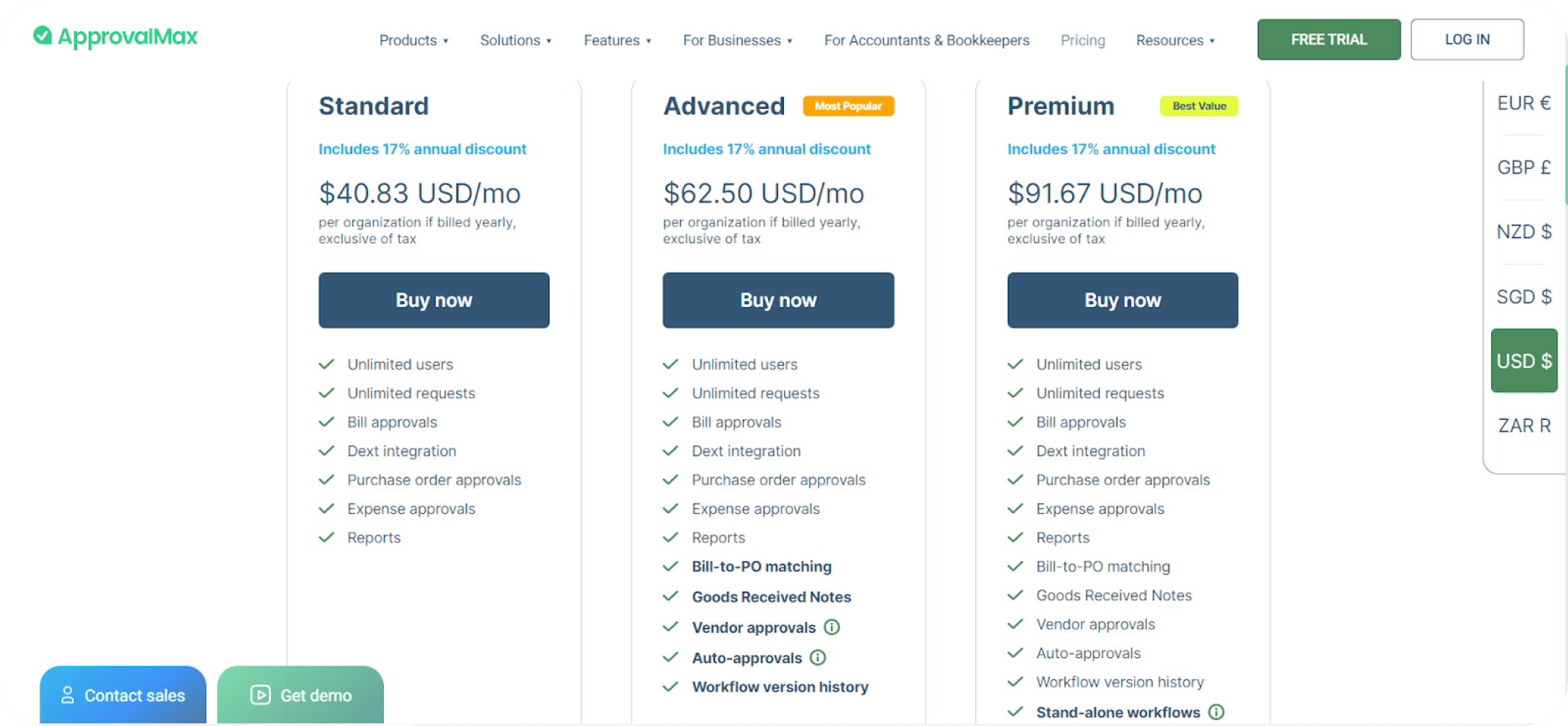
Approveit offers you to fill in the pricing form and customizes pricing for each customer, with the lowest tier charging $1200 per year; it doesn’t offer monthly payments.
Approveit has a pilot period instead of a free trial for a fee of $99.
This fee covers full access to all features, a personal onboarding manager, and full support in setting up the workflows.
Approveit forms the pricing based on the number of requests and workflows the team needs and the integrations they require. There is no limit to the number of systems you can connect to one account.
Conclusion
Both Approveit and Approvalmax have earned the right to exist and both solutions successfully attract clients.
However, it looks like they have different target customers, goals, and vision.
Approveit is a solution fit for businesses that scale and wish to retain agility while doing so. It aims to become a lightweight ERP and a decision-making hub for the whole organization. Building processes from the get-go and expanding the usage of one platform instead of purchasing 10 would be their top priority. It’s for companies who need something that works for 500 people as efficiently as it does for 50.
Approvalmax is a solid and simple app that solves an isolated problem of approvals in finance and accounting. It works well for those who have no wish to substitute their whole tech stack with one system, but prefer to keep things on different platforms. With that in mind, we need to understand that this approach fits best for small businesses with simple organizational structure. Scaling usage of 10 products may become a challenge since there will be no centralized control hub or helicopter view of the company’s operations.
Enjoyed the reading?
Subscribe to our fresh artiles, product updates and news

